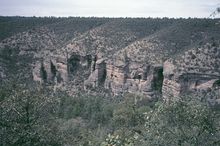Cuarenta Casas
Cuarenta Casas (Spanish; forty houses ) denotes a series of closely spaced cave structures in the western part of the Mexican state of Chihuahua . It is located on the north-western (ie facing the sun) rock edge of the small watercourse Arroyo del Garabato , around 41 km north of the small town of Madera .
Research history
The ruins were first documented at the end of the 19th century and examined superficially by the Norwegian Carl Lumholtz , who roamed the mountains of the Sierra Madre Occidental during this time . The archaeological classification was only possible in connection with the research of the North American archaeologist Charles DiPeso in Paquimé , formerly known as Casas Grandes . Then the cave settlements emerged during the so-called Buena Fe phase of Paquimé between 1060 and 1205. The decline of the smaller sites such as Cuarenta Casas was triggered by the destruction of Paquimé around the year 1340. Century descendants of earlier residents resided in the area and in the ruins.
General
The archaeological site consists of about a dozen small buildings under rock overhangs ( Abris ) or in shallow caves, up to 100 m above the bottom of the canyon. The number of forty houses is not to be taken literally and is intended to express a larger number. The buildings consist of adobe , partly of tapia . Spruce trunks were built in for reinforcement and for the roofs (also the floors of the second floor). The T-shaped doorways are characteristic.
Cueva de las Ventanas
The largest complex of Cuarenta Casas, the Cueva de las Ventanas (Cave of Windows), consists of a two-story construction. There are around 15 rooms on the ground floor, with two elongated aisle-like rooms (the front wall of which has largely not been preserved) giving access to the smaller, square rooms in the row behind. The 11 rooms on the second floor rest almost exclusively in these rooms, but hardly anything has survived. A reliable reconstruction is possible on the basis of old photographs (especially those by Lumholtz). Excavations have indicated that room 5, situated on a rock slightly elevated, was a maize store. A young man's grave was found in one of the neighboring rooms. The wall paintings that Lumholtz reported are no longer visible.
literature
- Arturo Guevara Sánchez: Guía oficial: Paquime y Las Cuarenta Casas. México , INAH, 1991. ISBN 968-32-0348-5
- Carl Lumholtz: Unknown Mexico: A Record of Five Years' Exploration among the Tribes of the Western Sierra Madre: In the Tierra Caliente of Tepic and Jalisco: and among the Tarascos of Michoacan New York 1902
Individual evidence
See also
Coordinates: 29 ° 33 ′ 13 ″ N , 108 ° 10 ′ 9 ″ W.


